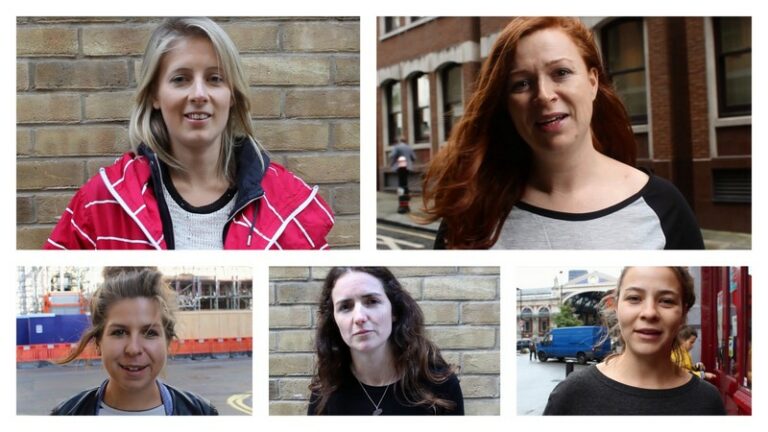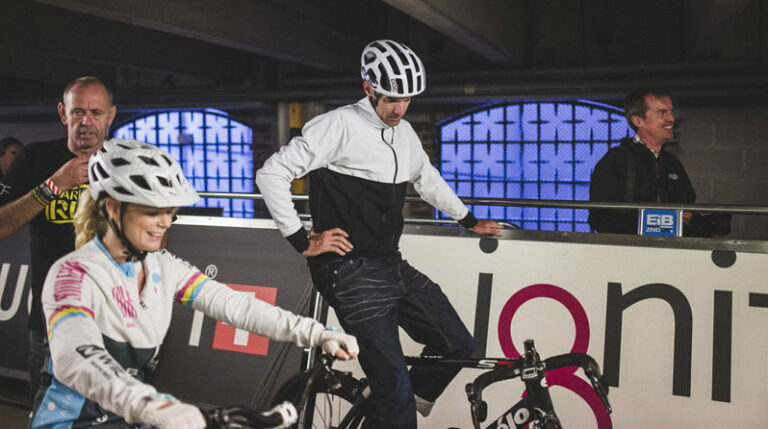
Seen THAT Colombian women’s cycling team kit? You might have laughed. You might have been shocked. You probably shared it. But there are much bigger, more important issues facing professional women’s cycling. Want to change things? Share THIS instead.
Earlier this week the internet was flooded with images of a certain women’s cycling team. The photo featured the team wearing, appropriately enough their team kit. What caused the fuss was that the central gold panel of the kit over the stomach and crotch region looked, due to a combination of bad lighting and a grainy photo, like it was – well – nude.
Does Pink Really Stink? Women’s Cycling Kit and Pinkification.
Inevitably enough it went viral, provoking the a range of responses, including those who decried the bad design, those who found it amusing and harmless, those who felt it was innappropriate and the trolls who used it as yet another opportunity to sexualise and demean female athletes.
It’s sad that one unfortunate photo of one team’s cycling kit has spread farther and wider than coverage of all the developments within women’s cycling that have been made this year. Although things have improved, with new races like La Course, and with increased TV coverage, there is still a long way to go.
So here are 5 things that are much bigger issues in professional women’s cycling than THAT cycling kit.
1. EQUAL PAY
2. EQUAL PRIZE MONEY
3. EQUAL RACING
4. EQUAL COVERAGE
5. EQUAL FUNDING AND OPPORTUNITIES

1. EQUAL PAY
There is no minimum wage for professional female road cyclists. It’s as simple as that really, but let’s expand.
The minimum wage for a Pro Tour riders is in the region of £27,000 and up. Most professional female cyclists are lucky to make £15,000. A lot of riders end up working as well as racing to have enough to live on.
Emma Pooley, Olympian, and World and National Champion, talked of wages earlier this year when announcing her retirement from pro road cycling to focus on triathlon. She mentioned that she could earn more winning a triathlon than a road race (more on that below) and, speaking to the BBC, stated ‘I’ve got a perfectly servicable degree, so I’m going to try and get some part-time work in engineering this year and next year. I need to pay the bills.’
It’s a sad day for the sport when some of its most talented athletes aren’t able to continue to race, or even fulfill their potential in the first place, because they can’t afford to ride.
There are even historical occasions where teams haven’t been paid at all, and a recent complaint made by Alessandra Giuseppina Grassi of the Estado de Mexico-Faren team suggest that there have been issues with pay as recently as this year for them.
However, many teams are working to set the bar where it should be. Wiggle Honda are able to pay better salaries to their riders through their sponsorship with Wiggle, the online retailer.
But it’s still a struggle, and there’s a long way to go yet.

2. EQUAL PRIZE MONEY
This year, when Marianne Vos crossed the finish line at the new La Course by La Tour de France race, she pocketed 22,500 euros, the same amount that Marcel Kittel received for finishing first on the final stage of La Tour. This is the exception, rather than the rule.
On the flipside let’s look at the 2014 Giro D’Italia and the sort-of-but-not-quite equivalent Giro Rosa.
The overall prize fund for the Giro d’Italia was nearly 1.3 million euros. Each stage win could net a rider 11,000 euros, and Nairo Quitana, who took the overall win at the Grand Tour race pocketed 200,000.
The overall prize fund for the Giro Rosa was in the region of 17,600 euros. The overall grand classification winner, Marianne Vos – one of the most talented, skilled professional athletes of all time, male or female – took home 535 euros. Now, through winning other stages and sections, it’s possible to boost this figure, but it’s hardly equivalent.
3. EQUAL RACING
You almost don’t need to delve too deeply into the UCI calender to see the issue here. All the UCI Elite Women’s races (87 of them) are clustered under the one tab. The men’s are numerous enough to warrant further categorization; the Africa Tour, Asia Tour, the Criteriums, the World Tours such as the Giro d’Italia and the Tour de France. In total, there are 543 events that the elite men could potentially ride in. It’s a simplified picture, but you get the idea.
Another issue is distance and duration, which are limited for women’s races by UCI rules which state that road stages must not exceed 130kms, while time trial stages are limited to 40kms.
The Tour Entier group, set up by Emma Pooley, Marianne Vos, Kathryn Bertine and Chrissie Wellington, campaigned for women to be allowed to ride arguably the most prestigious road race; the Tour de France. Although their petition was successful in helping the creation of La Course, they haven’t stopped campaigning. They state that the limits on women’s events aren’t supported by physiological evidence of what women can achieve.
Evelyn Stevens of Specialized Lululemon took matters into her own hands when she raced 17 days in a row (10 days of the Giro Rosa, then the 7 day Thuringen-Rundfahrt) covering over 900 miles to prove the point that physical ability is not a limiting factor for female cyclists.
And then there’s the fact that for years races have faced cancellation, sometimes at the last minute, due to funding issues, and the tour schedule for women’s teams can be erratic.
Things do seem to be changing here, with the new Friends Life Women’s Tour, seen as the equivalent to the men’s Tour of Britain, which had equal UCI status and prize money, and the new La Course by La Tour de France.
We want more! More racing, more opportunity for athletes to showcase their skills, for developing athletes to test themselves against the best, and for the world to see the athleticism and skill of the pro women’s peloton.

4. EQUAL COVERAGE
This year saw a vast improvement in coverage of professional women’s cycling, with both the UCI Women’s Road World Cup races and The Women’s Tour getting screen time from mainstream broadcasters, and the majority of La Course being broadcast live.
However, we’re still a long way away from parity with professional men’s cycling. The Tour of Britain which took place in September was screened live on ITV4 and British Eurosport. The Tour de France had live broadcasting on ITV and ITV4 as well as highlights programmes.
The rise of the internet is helping redress the balance, with sites such as Podium Cafe and bloggers such as Sarah Connolly blazing a trail, but actual video coverage remains elusive even online.
The infrastructure to broadcast a race; the cameramen on motorcycles, the helicopter coverage, just isn’t present at the majority of women’s events. Where it is, such as at the Friends Life Women’s Tour, there is still no live online feed.
More coverage for riding also means more incentives for sponsors, which brings more money into women’s cycling. Innovative teams like Wiggle Honda have begun to take things into their own hands, producing their own videos and interviews.
5. EQUAL FUNDING & OPPORTUNITY
It’s not just about the women who are racing now – what about the next generation? The Victoria Pendletons, Emma Pooleys, and Marianne Voses of the future?
Going back to the UCI calender, there are 48 Junior Men’s events globally, but only 12 for Junior Women.
Even at an Elite level, competition for resources can mean that opportunities are cut, for example when British Cycling announced it would not be fielding a British woman for the 2014 World Time Trial Championships.
Some teams, like the Matrix Fitness Vulpine domestic team, make a point of using their resources to help grow talent, and many of their riders have gone on to huge success. The team itself benefited greatly from being the only domestic team to participate in The Women’s Tour.
If we want the UK to continue to produce world class athletes, we need to support and develop them.
There is lots more we could say, many more examples we could give, and lots more detail we could go into – and if you are interested the information is out there. But the fundamental point remains – although support for professional women’s cycling has come on massively this year, and great things have been achieved, we are not there yet. We must keep raising these issues, developing the sport, flagging inequality, and campaigning for things to change.
Like this? You’ll find these a fascinating read too.
Why Sponsorship is Essential to the Growth of Women’s Road Cycling
Body Image Issues: A Worrying Issue in Women’s Cycling





